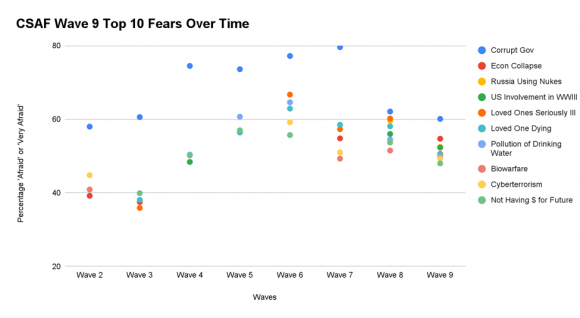
The Top 10 Fears in America 2023 Are your Fears on the List?
October 20, 2023
This fall marks the ninth wave of the Chapman University Survey of American Fears (CSAF). Conducted annually, the CSAF reveals the top 10 fears in America, following trends over time and identifying new fears as they emerge. The CSAF surveys a nationally representative sample to understand the fears that keep Americans up at night.
Wave 9 was conducted in the spring of 2023 by asking a random sample of 1,014 adults across the United States about ninety-seven different fears ranging from topics about the environment, government, the economy, war, natural disasters, and many more.
Samuel Andrus (‘23 Political Science) compiled the list from the work of Wilkinson College Undergraduate Research Fellows in the Henley Lab and Babbie Center (including Andrus) who have also completed research papers based on the survey.
Fears are ranked by the percentage of Americans surveyed who reported being ‘afraid’ or ‘very afraid.’
Top 10 Fears of 2023 % of Very Afraid or Afraid
Corrupt government officials 60.1%
Economic/financial collapse 54.7%
Russia using nuclear weapons 52.5%
The US becoming involved in another World War 52.3%
People I love becoming seriously ill 50.6%
People I love dying 50.4%
Pollution of drinking water 50.0%
Biological warfare 49.5%
Cyber-terrorism 49.3%
Not having enough money for the future 48.0%
General Overview of America’s Top 10 Fears of 2023
The top 10 fears in the 2023 survey suggest that Americans’ fears center on five main topics: corruption in government (number 1), economic concerns (numbers 2 & 10), war and terror (numbers 3, 4, 8, & 9), the harming or death of loved ones (numbers 4 & 5), and pollution of drinking water (number 7).
Wave 9’s top 10 list is very similar to last year’s, comprising most of the same fears in varying order. The only exception is the replacement of the fear of pollution in oceans, rivers, and lakes with the fear of cyber-terrorism, both occupying the number 9 position.
It’s worth noting the overall decrease in percentages. In the 2020/21 survey, the number 1 fear (corrupt government officials) held 79.6% of respondents ‘afraid’ or ‘very afraid,’ and only the number 10 fear had a percentage lower than 50%. In 2022, the number 1 fear (see above) dropped more than 10% but every fear in the top 10 was above 50% with two being above 60%. This year, only the number 1 fear (see above) was above 60%, but just barely. Besides the number 1 fear, no other fear in this year’s top 10 garnered above 55% and numbers 7-10 were at 50% or below. This trend points to an overall decrease in the average American’s likelihood of being ‘afraid’ or ‘very afraid’ of the topics included in the top 10 fears.
Government Corruption: America’s Biggest Fear
Skepticism of government is baked into America’s political culture, and fear of corrupt government officials has remained the number one fear in America since first topping the chart eight years ago in 2015. However, the percentage of respondents who are ‘very afraid’ or ‘afraid’ of corrupt government officials has dropped from 62.1% in 2022, and further from its height in 2020/21 (79.6%).
The 2020 election, now almost three years behind us, marked a time of increased fear about the security of our democracy. Widespread calls of election fraud and the January 6th insurrection no doubt contributed to the fear of corrupt government officials reaching its high in the 2020/21 survey. With the January 6th hearings of last year attempting to hold perpetrators accountable and the relative mundanity of the Biden administration compared to the chaos of Trump, it follows that America’s biggest fear would decrease. Although more Americans still fear corrupt government officials more than anything else, at 60.1% this year, fear of corrupt government officials is at its lowest point since 2015 (58.0%).
Economic Concerns in America Increasing
Since the first Chapman Survey of American Fears was conducted in 2013, at least one fear related to the economy has appeared in the top 1o. Fear of economic/financial collapse held steady this year, increasing 1% from 2022 where it ranked number 8 with 53.7% of respondents being ‘afraid’ or ‘very afraid;’ this year the fear ranked number 2 despite only a marginal increase in responses.
Considering this year’s high interest rates, high inflation, and unexpected banking crisis; economic recession was something a lot of Americans were afraid of, helping to explain why fear of economic/financial collapse ranked so high. Additionally, many Americans are still feeling the economic impact of the pandemic, which coupled with the beginning of massive layoffs in the tech-sector, brought down a heavy burden on individuals trying to make ends meet. These factors shed some light on why many Americans are afraid of not having enough money for the future.
War and Terror
Despite only being added to the survey last year, the fear of Russia using nuclear weapons has maintained its position as the number 3 fear in America, decreasing from 59.6% in 2022 to 52.5%. The war in Ukraine and the persistent media coverage of it, as well as the uncertainty whether Vladmir Putin might use nuclear weapons in his effort to take over Ukraine, explain why this fear has risen so high in the past two years. Further, the war in Ukraine has manifested in a greater fear of the United States becoming involved in a third world war. That fear has risen from number 5 last year to number 4 this year, albeit losing 3.7% from 2022. The threat of Russia using nuclear weapons also ties in here as many fear it may force the United States to increase its involvement, potentially escalating the conflict to another world war.
Also included in this year’s top 10 are the fears of biological warfare and cyber-terrorism. Debunked claims from Russian authorities have provoked conspiracy theories over the use of biological weapons in Ukraine, bringing the issue a lot of attention, despite the fact no such weapons exist.
Biological warfare first entered the top 10 fears in the 2020/21 survey, the first conducted after the outbreak of COVID-19. Its retention on the list and its increase from number 10 in 2022 to number 8 (despite a 2% decrease) points to some of the long-lasting fears brought on by the pandemic.
Cyber-terrorism reappears on Wave 9’s top 10 list after being absent in 2022. Cyber-terrorism was the number 7 (59.2%) fear in America in 2019 and fell to number 8 (51%) in 2020/21, now ranking number 9 with 49.3% of respondents being ‘afraid’ or ‘very afraid.’ Bipartisan groups of lawmakers have been introducing and passing cybersecurity legislation over the past year as rhetoric concerning Chinese cyber-capabilities continues to make it clear that the People’s Republic of China represents the biggest cyber threat to America. This fear of cyber-terrorism, specifically its implications concerning China, and to a lesser extent, Russia, is also in conjunction with the fear of the U.S. becoming involved in another world war.
Fear of Illness or Death of Loved Ones Diminishing
From last year, the fear of loved ones becoming seriously ill fell from number 2 and 60.2% of respondents being ‘afraid’ or ‘very afraid,’ to number 5 with only 50.6% of respondents being ‘afraid’ or ‘very afraid.’ This could represent the growing number of Americans who have received vaccinations against COVID-19 and the years that have passed since the initial outbreak. Interestingly, when asked about the fear of themselves becoming seriously ill, only 35% of respondents answered ‘afraid’ or ‘very afraid.’ This reveals a greater concern for the health of others rather than one’s own self. A possible explanation for this could be the emphasis on protecting the most at-risk individuals in one’s family during the pandemic.
The fear of loved ones dying also fell from number 4 with 58.1% of respondents answering ‘afraid’ or ‘very afraid’ in 2022 to number 6 with 50.4% of respondents ‘afraid’ or ‘very afraid.’
Both of these fears have landed in the top 10 every year except for 2017. From 2019 to 2022, they remained in the top 5 fears.
Environmental Concerns Continue to Fall
This year’s survey followed the trend of diminishing environmental concerns. Beginning in 2017, four out of the top 10 fears were related to the environment. In 2018 and 2019, five out of the top 10 fears concerned the environment with pollution of oceans, rivers, and lakes holding the number 2 spot both years, followed by pollution of drinking water in the number 3 and subsequently number 4 slots. In this year’s top 10, only the fear of pollution in drinking water remained in the top 10, in the number 7 slot with 50% of respondents being ‘afraid’ or ‘very afraid.’ This is a 4.5% decrease from last year when it was number 6. Pollution of drinking water did not appear in the top 10 fears of the 2020/21 survey, however, pollution of oceans, rivers, and lakes, which was absent this year, appeared in the number 9 position (and held onto it in 2022), a huge drop from its number 2 position in 2019.
With the ongoing war in Ukraine, growing economic troubles, the persistence of pandemic-related health concerns, and an already intense political climate ahead of the 2024 presidential election, it is unfortunate but not all that surprising that the environment has lost focus in recent years. From the substantial drop of concern for the pollution in oceans, rivers, and lakes between 2019 and 2020/21, it would appear as if the pandemic and its increase on health-related fears is the principal culprit for displacing environmental fears in the top 10. The absence of this fear in Wave 9, replaced by fear of cyber-terorrism this year, points to a greater emphasis on external threats to the American public rather than environmental degradation.
Lastly, the sole environmental fear staying on the list being narrowly focused on drinking water speaks to the everyday experience of Americans. Pollution of drinking water, such as what is occurring in Jackson, Mississippi or Flint, Michigan, directly impacts Americans; whereas pollution of the ocean, rivers, or lakes may take longer for its harmful effects to trickle into the American consciousness. Despite decades of climate activism and awareness, fear of global warming and climate change hasn’t made it into the top 10 fears since 2019, before the pandemic.
Faced with so many things to be afraid of, the hierarchy of fears provided by the top 10 fears of Wave 9 help give insight into the ways average Americans cope with the onslaught of threats in such an uncertain world.
Wave 9’s Top 10 Fears in Past Surveys (Figure 1):
The above scatter chart (figure 1) tracks the top 10 fears from Wave 9 to previous top 10 lists where they have appeared.
The result of tracking these trends illustrates the grip fear of corrupt government officials has had on the American psyche, as well as the emergence of contemporary fears such as Russia using nuclear weapons or the U.S. becoming involved in another world war.


